CPAP pillows are a crucial element in achieving successful CPAP therapy. They provide support and comfort while allowing patients to sleep in any position. But with so many options on the market, it can be difficult to know which CPAP pillow is right for you.
Choosing the best CPAP pillow comes down to individual preferences and needs. But with our comprehensive guide, you can make an informed decision that will help you get the restful sleep you deserve.
Our complete review breaks down the pros and cons of each option, including memory foam, contour, and water-based pillows. We also explore special features like adjustable height and removable covers.
How Does a CPAP Pillow Work?

CPAP pillows are specially designed to provide comfort and support for individuals using continuous positive airway pressure machines during sleep and deliver pressurized air through a mask, often used to treat obstructive sleep apnea.
CPAP pillows have indentations or cutouts for the mask, CPAP hose, and shoulders, creating an even surface for the head and neck throughout the night. These pillows may also be made of materials specifically suited for CPAP users, such as noise-reducing fabrics and contoured foam.
In addition to providing comfort and support, CPAP pillows also help to reduce leakage from the CPAP mask, ensuring more effective treatment.
Overall, CPAP pillows can greatly enhance the comfort and effectiveness of CPAP therapy during sleep.
The Top 5 Best CPAP Pillows for Sleep Apnea
Here are some CPAP pillows that might help ease the symptoms of sleep apnea and make it easier to get a good night’s sleep.
Contour CPAPMax CPAP Pillow 2.0

The FSA and the HSA have validated this pillow, and it performs admirably regardless of your preferred sleeping position, be it on your back, stomach, or side. The ergonomic cutouts create the proper contouring in the mask, which maximizes both alignment and ventilation. Additionally, the cutouts provide pressure-free zones in which your CPAP equipment can rest comfortably without interfering with your sleep in the way it frequently does when used with conventional pillows.
Concave centers on pillows are helpful for those who use CPAP machines for several reasons. While you relax, your head will be supported in a comfortable cradle, and you won’t have to worry about putting any strain on your neck or head. In addition, there is a band on the side that you can use to secure the hose of your CPAP machine.
EnduriMed CPAP Pillow
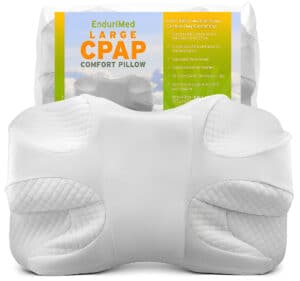
The Endurimed CPAP Pillow is constructed entirely of memory foam, which enables it to conform to the unique shapes of your face, neck, and head. The pillow has two different levels of thickness, making it neither overly soft nor overly firm.
This allows it to maintain an ideal placement that is good for the neck and the spine. This support is essential for alleviating the aches and pains in your neck and back, allowing you to sleep more comfortably while using your CPAP machine.
The manufacturer claims the design is appropriate for those who sleep on their fronts, backs, or sides. Because of its design, this pillow enables sleepers to move around more freely throughout the night without the risk of the wires attached to their mask getting tangled.
In reviews that favor this product, it is mentioned that it is a soft and comfortable pillow that aids in keeping a person’s CPAP mask in place. It has been mentioned in reviews that it may not provide completely sufficient support for the head or the neck.
Lunderg CPAP Pillow
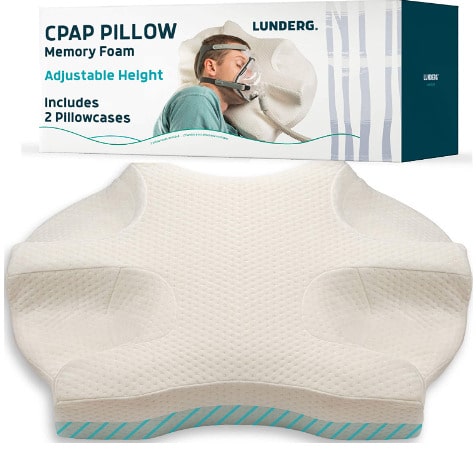
The Lundberg CPAP Pillow for Side Sleepers features a distinctive design from other similar products. Each side of the pillow has a different thickness, allowing you to customize your level of support and comfort to suit your preferences. If you require an additional layer of density, it also includes an additional layer of memory foam you may choose to use.
When it comes to CPAP machines, this pillow is compatible with any brand and any model of CPAP machine. However, to use it, you need to sleep on your side. Back and Stomach sleepers won’t get nearly as much support or comfort from this mattress. This pillow comes with two pillowcases that are the perfect size to fit over the pillow.
Some purchasers have reported neck pain from using this pillow, while others have stated that they did not notice an improvement in the quality of their sleep. If you have a problem with your neck, this pillow might not provide you with the necessary amount of support.
Carex CPAP Pillow
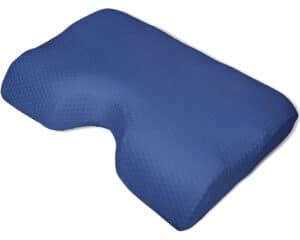
Are you looking to improve the comfort of your mask while you sleep? The Carex CPAP Pillow was developed specifically with this purpose in mind even though it has a very firm cushion. It allows you to move your head and neck freely during the night so that you won’t feel stuck in one position.
This particular cushion can prevent leaks from a CPAP mask, which is something that other pillows are unable to achieve. This is a common issue for those who sleep on their sides, but with the Carex, you may tilt the mask exactly how you need to without experiencing a leak. It is possible to accommodate both the mask and the hose, resulting in a more restful night’s sleep.
This is a decently sized cushion; however, due to its high level of firmness, it may not be suitable for everyone. No height adjustment is available, which may be necessary for specific individuals. It is possible that the pillow, if it had some cutouts on the side, would be better able to handle a mask and hose.
FitPlus Premium Wedge Pillow
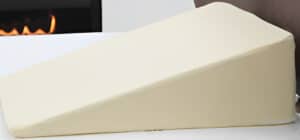
Even though people with sleep apnea should avoid sleeping on their backs, it can be challenging to change how they are accustomed to sleeping, and it may be easier to find a pillow that will better support this position if you are sitting down while you hunt for one.
One such example is provided by edge pillows, which, when used while sleeping on your back, assist in elevating the upper body. This reduces the pressure that gravity exerts on your airways, which helps keep them open.
The 1.5-inch layer of memory foam that offers the surface gentle, contoured comfort will maintain your body at a mild incline. Thanks to the high-density foam underneath. This position will feel quite natural to you. This not only helps to retain your spine in its natural alignment, but it also has the potential to alleviate a wide variety of other conditions, including acid reflux, snoring, and allergies, to name just a few.
When using a CPAP machine, people who sleep on their backs may want to experiment with a wedge pillow since it serves two purposes: it helps keep the airway open more naturally, and you can use the machine without any interruption.
How Are CPAP Pillows Different from Other Types of Pillows?
CPAP pillows are designed with parts and margins that have been cut away precisely to ensure that the exhalation vents in the mask are not blocked in any way. This guarantees you a consistent supply of therapeutic air from the CPAP machine.
These pieces that have been taken out also keep the seal from disturbances. When your mask isn’t on the right and moves around, it can cause problems with your seal.
When you use regular pillows to support your head while you sleep, any adjustment in posture or movement of your body may cause your head to move laterally or upward, which in turn causes the mask to shift as well. This is impossible with a CPAP pillow due to its segmented shape and cutouts, which prevent air from escaping.
In addition, CPAP pillows are typically crafted from memory foam. This makes it easier for the pillow to support your mask while providing optimal relief for your head, neck, and spine and ensuring that you maintain the correct posture while you sleep.
The support provided by fiber CPAP pillows is comparable to that provided by other types, but they offer a higher level of comfort.
The Common Sleeping Postures
If you use a CPAP machine while you sleep, it’s essential to find a pillow that works with your sleeping position so that your neck and spine stay in proper alignment. The following are some of the most typical sleeping postures adopted by people who use CPAP:
- Left-Side Sleeping
- Right-Side Sleeping
- Supine (Back) Sleeping
- Stomach Sleeping
When utilizing a CPAP machine, you can take advantage of whatever sleeping position is most comfortable for you, regardless of whether you prefer to sleep on your back, stomach, or side.
But we recommend that those who sleep on their stomachs or backs use thinner pillows, while those who sleep on their sides should use thicker, firmer options.
The mask’s choice is essential for the correct application of the product. If you have been instructed to use a CPAP machine, you will need to locate a mask and a pillow that will maintain your position while using the device.
Tips for Choosing the Best CPAP pillow

When shopping for a CPAP pillow to treat sleep apnea, a person might want to take into consideration the following aspects:
Sleeping Position
When lying on your stomach, the most comfortable position is usually one in which you use a soft, thin pillow. A firm or extra-firm pillow is ideal for those who sleep on their sides. Personal preference is a major factor.
Pressure Relief
Additionally, particular CPAP pillows encourage healthy alignment of the spine. If someone suffers from chronic neck pain, they should consider the supportiveness and firmness of the materials used in the pillow of their choice.
A person can also choose manufacturers that offer free sleep trials so they can try their pillow and see if it helps with neck pain and lets the pressure off where it needs to.
Pillow Angle
It’s possible that sleeping on your back could make your sleep apnea symptoms worse. If, on the other hand, you can only fall asleep when lying flat on your back, you might find that raising your upper body using something like a wedge cushion is more effective.
CPAP Machine
A person needs to purchase a CPAP pillow that can handle their CPAP machine if they use one. When using a CPAP machine, some people find that sleeping on their side is the most comfortable position. These individuals should look for a pillow designed for people who sleep on their sides.
Firmness
A person’s level of firmness in their pillow is a matter of personal preference. Some people may require a firmer pillow to keep their cervical spine aligned and their head in a suitable posture for relieving their sleep apnea, while others may prefer a softer cushion for more comfort.
Pillow Height
There is a wide range of sizes available for sleep apnea pillows, ranging from those with thinner designs to those with thicker wedge-shaped cushions. When choosing a pillow, it is vital to think about what feels most comfortable to you and helps relieve the symptoms you are experiencing.
Advantages of Using a CPAP Pillow
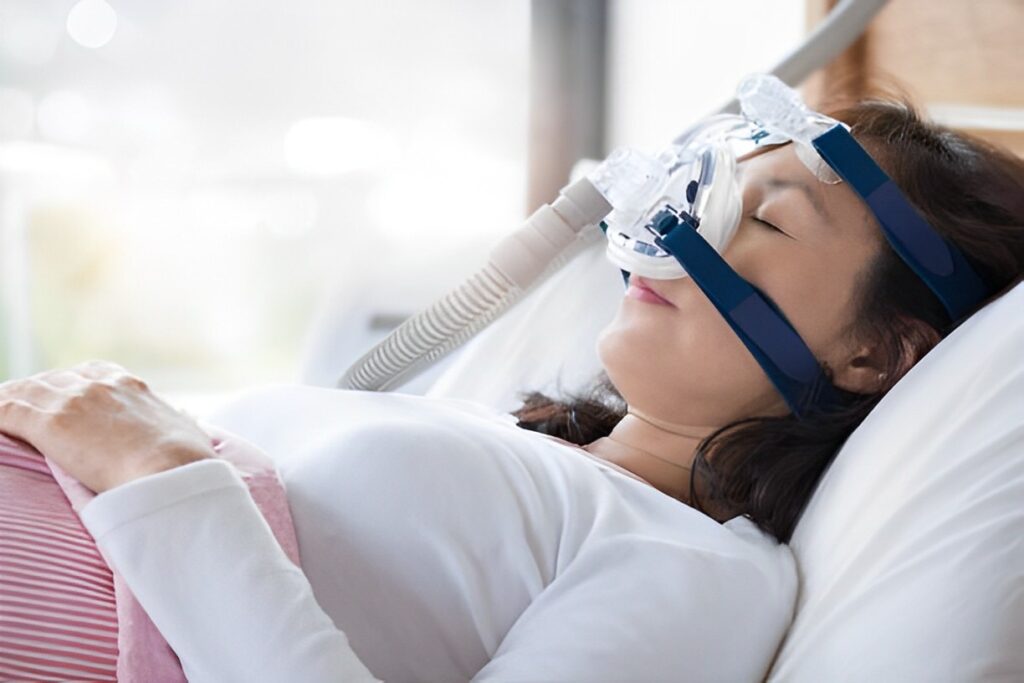
Suitable for Use with Full Face Masks
There are a lot of CPAP pillows that can fit full face masks. Regular pillows have difficulty doing this, making lines that don’t look right and leading to hose leaks.
Sleep On Any Side
When you lie down, you can sleep on a particular CPAP pillow on your stomach, side, or back. However, some pillows are only good for people who sleep on their sides, and others can help both back and side sleepers. Those who sleep on their stomachs can also locate pillows tailored to their sleeping position.
Support for Orthopedics
Because these diseases can cause pain in the neck and back, people who wear CPAPs frequently require additional orthopedic assistance. These pillows keep the head and neck in proper alignment while supporting the shoulders.
Maintenance Recommendations

The Laundry and the Drying
At the very least once each week, you should wash the cover of your pillow thoroughly and then let it air dry. Be sure to follow the washing directions carefully since failure to do so may cause the cover to become too small.
Maintaining the cleanliness and functionality of your CPAP device also requires routine cleaning of the case. Here are the best ways to clean your CPAP machine.
Hypoallergenic covers
If you so wish, you may make your purchase of these pillows, complete with allergen-free covers. Verifying the material used to construct yours is necessary if you want to establish whether or not the material in question is hypoallergenic. These covers are excellent for people who have skin that is prone to irritation or who suffer from severe allergies.
Conclusion
If you are considering purchasing a CPAP pillow, there are several factors to consider to make the best decision for your individual needs.
In this blog post, we have provided a comprehensive review of the different types of CPAP pillows on the market and tips for choosing the right one for you.
We hope this information will help you make an informed purchase and get the most out of your CPAP therapy.
Are you still unsure which pillow is right for you? Contact our team today for a free consultation – we would be happy to help!
Frequently Asked Questions
Is it possible that sleeping with an elevated head could help with sleep apnea?
Using a wedge cushion or an adjustable bed to raise the head of the mattress can help some people with sleep apnea. In this case, lifting the head helps since gravity opens the airway and can also minimize snoring, which can help lessen the number of apnea episodes that occur.
If you have sleep apnea, will a cervical pillow help?
Cervical pillows can alleviate neck pain, but they were not developed to assist persons who suffer from sleep apnea. If you tend to sleep on your back, suffer from neck pain, and suffer from sleep apnea, you could discover that a cervical pillow is more comfortable.
Do sleep apnea pillows really work?
Suppose you can locate the ideal sleep apnea pillow to complement your sleeping habits. In that case, you will experience an increase in comfort, which may also assist you in maintaining an open airway throughout the night. Additionally, some sleep apnea pillows can assist keep tubes from becoming entangled.
Are CPAP pillows worth it?
The purchase of these pillows is well worth it because they can better accept all kinds of masks, allowing for a better night’s sleep.
So, have you decided to buy a CPAP pillow after reading these reviews?




